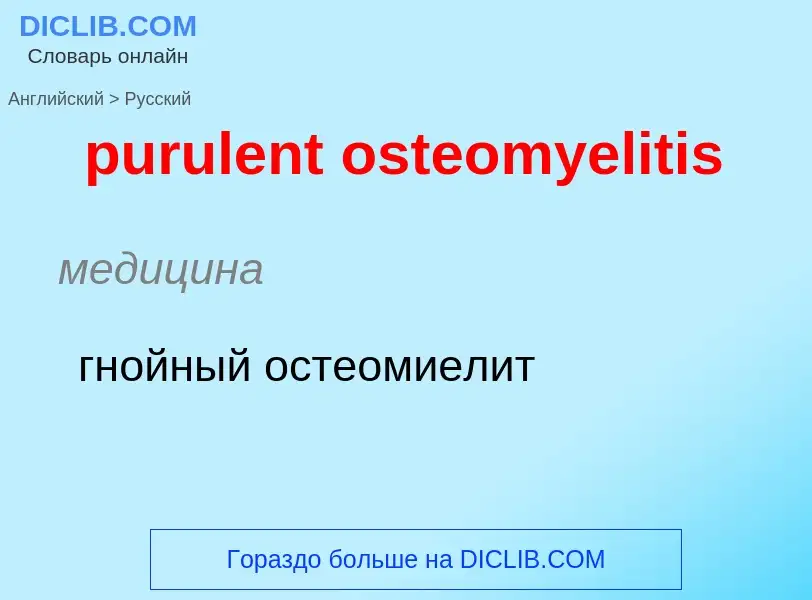Translation and analysis of words by ChatGPT artificial intelligence
On this page you can get a detailed analysis of a word or phrase, produced by the best artificial intelligence technology to date:
- how the word is used
- frequency of use
- it is used more often in oral or written speech
- word translation options
- usage examples (several phrases with translation)
- etymology
purulent osteomyelitis - translation to russian
медицина
гнойный остеомиелит
медицина
гематогенный остеомиелит
[ɔstiəumaiə'laitis]
ортопедия
костоеда
остеомиелит
существительное
медицина
остеомиелит
Definition
Wikipedia

Osteomyelitis (OM) is an infection of bone. Symptoms may include pain in a specific bone with overlying redness, fever, and weakness. The long bones of the arms and legs are most commonly involved in children e.g. the femur and humerus, while the feet, spine, and hips are most commonly involved in adults.
The cause is usually a bacterial infection, but rarely can be a fungal infection. It may occur by spread from the blood or from surrounding tissue. Risks for developing osteomyelitis include diabetes, intravenous drug use, prior removal of the spleen, and trauma to the area. Diagnosis is typically suspected based on symptoms and basic laboratory tests as C-reactive protein (CRP) and erythrocyte sedimentation rate (ESR).This is because plain radiographs are unremarkable in the first few days following acute infection. Diagnosis is further confirmed by blood tests, medical imaging, or bone biopsy.
Treatment of bacterial osteomyelitis often involves both antimicrobials and surgery. In people with poor blood flow, amputation may be required. Treatment of the relatively rare fungal osteomyelitis as mycetoma infections entails the use of antifungal medications. In contrast to bacterial osteomyelitis, amputation or large bony resections is more common in neglected fungal osteomyelitis, namely mycetoma, where infections of the foot account for the majority of cases. Treatment outcomes of bacterial osteomyelitis are generally good when the condition has only been present a short time. About 2.4 per 100,000 people are affected each year. The young and old are more commonly affected. Males are more commonly affected than females. The condition was described at least as early as the 300s BC by Hippocrates. Prior to the availability of antibiotics, the risk of death was significant.



![[[Mycobacterium doricum]] osteomyelitis and soft tissue infection. Computed tomography scan of the right lower extremity of a 21-year-old patient, showing abscess formation adjacent to [[nonunion]] of a right femur fracture. [[Mycobacterium doricum]] osteomyelitis and soft tissue infection. Computed tomography scan of the right lower extremity of a 21-year-old patient, showing abscess formation adjacent to [[nonunion]] of a right femur fracture.](https://commons.wikimedia.org/wiki/Special:FilePath/Mycobacterium doricum Osteomyelitis and Soft Tissue Infection.jpg?width=200)

